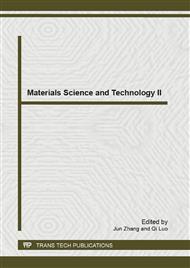[1]
Lugt H J, Introduction to vortex theory [M], Vortex Flow Press, 1996, Potomac
Google Scholar
[2]
Di F F, Di F D, Felli M, et al. , Experimental investigation of the propeller wake at different loading condition by PIV [J], J Ship Res, 2004,48 (2): 168-190
DOI: 10.5957/jsr.2004.48.2.168
Google Scholar
[3]
Mario F, Fabio D F., Analysis of the propeller wake evolution by pressure and velocity phase measurements [J], Exp Fluids, 2006, 41: 441–451
DOI: 10.1007/s00348-006-0171-4
Google Scholar
[4]
Bark G., Grekula M, Bensow R, and Berchiche, N, On Some Physics to Consider in Numerical Simulation of Erosive Cavitation [C], Proceedings of the Seventh International Symposium on Cavitation, 2009, Ann-Arbor, MI.
Google Scholar
[5]
Shin H R, Takafumi K., Propeller cavitation study using an unstructured grid based Navier-Stokes Solver [J], ASME J Fluids Eng, 2005, 127(9): 986-994
DOI: 10.1115/1.1989370
Google Scholar
[6]
Rickard E B, Goran B., Implicit LES predictions of the cavitating flow on a propeller [J], ASME, J Fluids Eng, 2010, 132(4):041302-1~041302-10
Google Scholar
[7]
Singhal, A K, Athavale M M, Li H Y, and Jiang, Y., Mathematical Basis and Validation of the Full Cavitation Model [J], ASME J. Fluids Eng, 2002, 124(3): 617–624
DOI: 10.1115/1.1486223
Google Scholar
[8]
Zhu ZF, Fang SL, Numerical Investigation of Cavitation Performance of Ship Propellers, Journal of Hydrodynamics 24(2012) 347-353.
DOI: 10.1016/s1001-6058(11)60254-0
Google Scholar
[9]
Zhu ZF, Fang SL, Wang XY, Characteristic Analysis of Unsteady Viscous Flow around a Cavitating Propeller, Science China: Technical Science 53(2010) 1983-1992.
DOI: 10.1007/s11431-010-3226-y
Google Scholar
[10]
Francesco Salvatore, Claudio Testa, Luca Greco., A Viscous/Inviscid Coupled Formulation For Unteady Sheet Cavitation Modelling Of Marine Profellers [C], Fifth International Symposium on Cavitation (CAV2003)Osaka, 2003,Japan, November 1–4,: 1-16
Google Scholar


